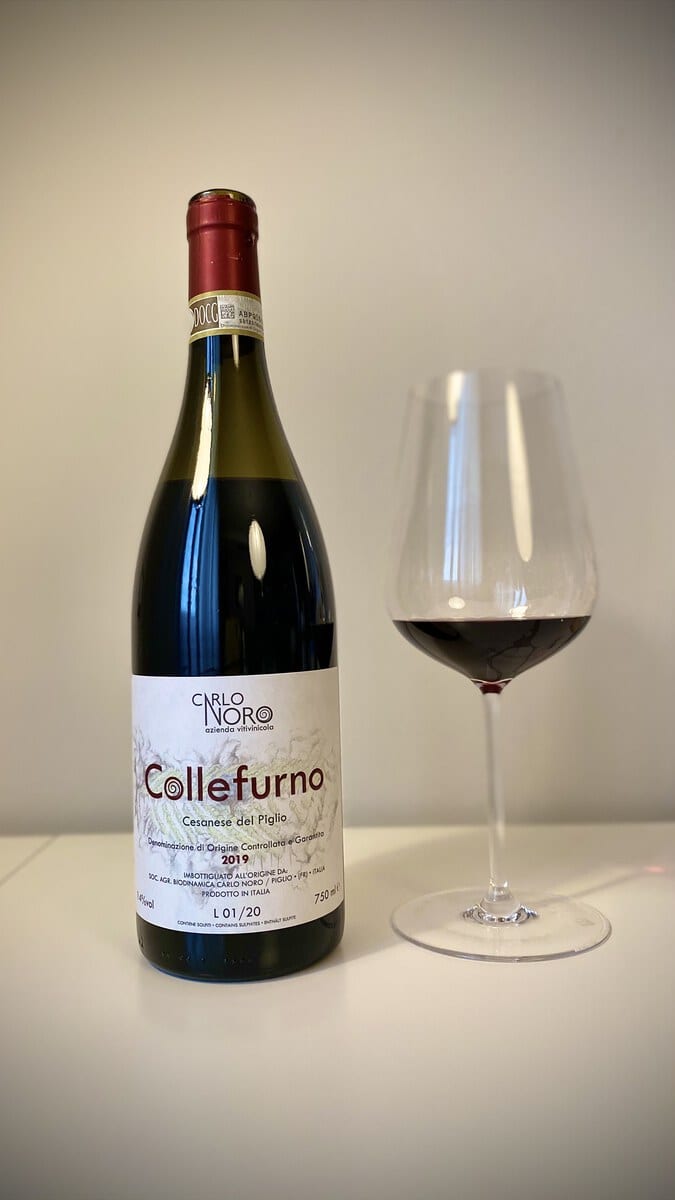Carlo Noro "Collefurno - Cesanese del Piglio DOCG" 2019
100% Cesanese d'AffileElegant and complex. Raspberry, violets, underwood.
Tasting Notes
Collefurno 2019 Cesanese del Piglio DOCG has a beautiful ruby coulor.
On the nose it opens with strawberry and raspberry notes. At a second sniff some softer notes come to mind, violet, underwood, mushroom and graphite.
The mouthfeel is spicy with nicely integrated tannins and freshness. This makes me think that this wine would be great if opened in a 5/6 years. It’s light body and elegant. On the palate I find those same juicy, red berry notes. The finish is long, with toasty, dark chocolate notes and some pleasant bitterness.
It’s a fine, elegant wine to have now or keep aside for a few more years. It will develop beautifully!

|
|
Carlo Noro |
|
|
Collefurno - Cesanese del Piglio DOCG |
|
|
Red & Still |
|
|
Italy |
|
|
Lazio |
|
|
Cesanese d'Affile |
|
|
2019 |
|
|
How it's made
Made with grapes grown according to biodynamic processes. Grapes are hand-picked, then spontaneously fermented and matured in barrels for 16 months before being aged 4 months in the bottle. It’s a natural wine, unfiltered, it undergoes minimal intervention.
Learn more
Barrel size
The barrel size is rather important and matters for two reasons.
-
One; wine notes (also) depends on the chemical compounds in the wood - almost always oak. The “flavours” associated with oak fermenting are vanilla, coconut, cinnamon, clove among others.
-
Two; wine will oxidise in barrels. That is because some oxygen reaches the wine through the cask, via its cracks and joints.
Big vs Small barrel
In a bigger vessel the ratio of wood to wine will be smaller than in a smaller barrel.
The same applies to the ratio of oxygen to wine.
So, wine fermenting in a foudre will oxidise less than wine fermenting in a demi-barrique.
It will also be in contact with less wood and its compounds. Thus wine from a bigger cask will show less of those notes associated with oak fermentation.
Some common barrel sizes are:
- Demi-Barrique : 112L;
- Bordelaise : 225L;
- Bourguigone: 228L;
- American Oak Hogshead: 300L – (79 US Gallons)
- Puncheon 500L;
- Demi-Muid 600L;
- Foudre 2000-12000L;
Barrel wood types
Barrels for wine making are almost only made of oak. Occasionally other types of wood are used, such as acacia and cherry.
One mature oak tree, after growing for decades, will result in only two barrels. So barrels are a rare, expensive tool!
Barrels can be French or American oak. Sometimes they are made of Slavonian oak.
America vs France
With “American” oak, what we really mean is oak from the States, Missuri generally. Because of the differences in climate, French oak is more “dense” than its American sibling. This seems to have an impact in the wine. With denser wood less oxygen passes onto the wine. So, broadly speaking, American oak barrels will pass more “flavours” and oxidise the wine more. That is why, American oak seems to be better suited for fermenting bolder grapes, which can better “take” a stronger interaction of the wood and oxygen influence.
American oak is not only used in the New World. IN the same way, French oak is not only used in Europe. For example, American oak is famously used in the production of Rioja wine in Spain.
As for Slavonian oak, it seems to add a different flavour spectrum to the wine, with notes of clove and nutmeg as well as more “richness” to the texture of the final wine.
Link to here...
